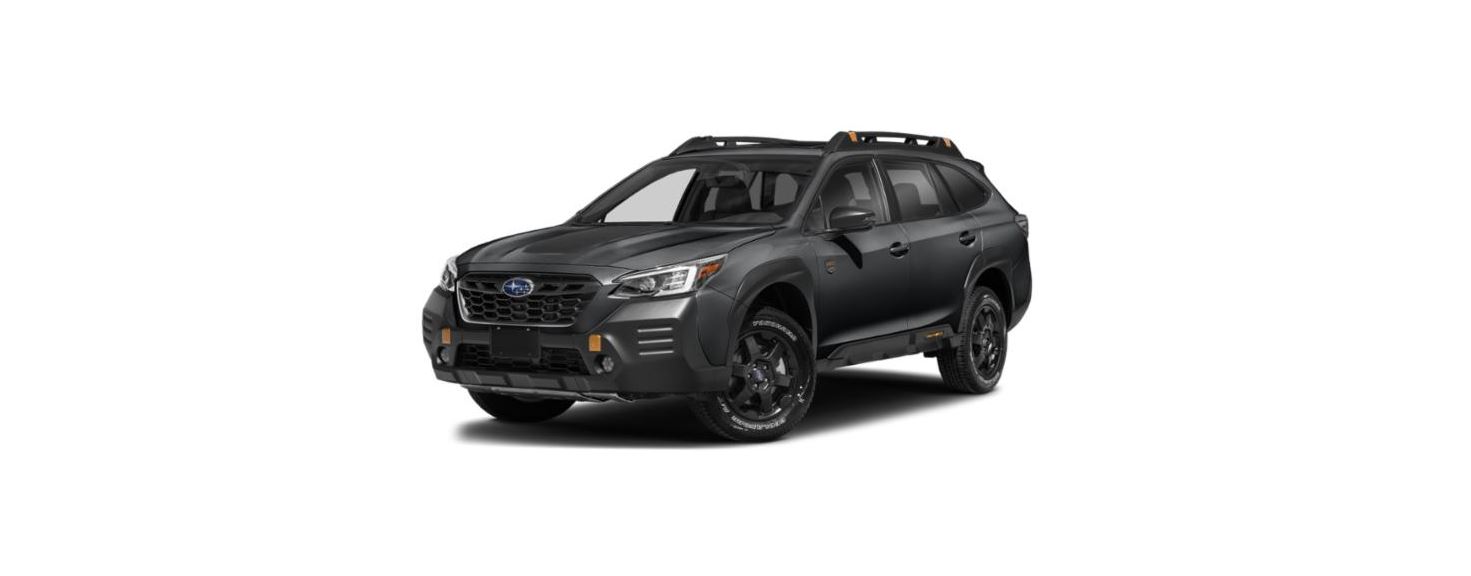2022 Subaru Outback Child Restraint Systems
Child Restraint Systems
Safety Precautions
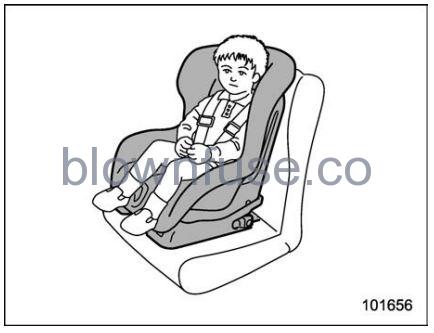
Infants and small children should always be placed in an infant or child restraint system in the rear seat while riding in the vehicle.
You should use an infant or child restraint system that meets Federal Motor Vehicle Safety Standards or Canada Motor Vehicle Safety Standards, is compatible with your vehicle and is appropriate for the child’s age and size.
All child restraint systems are designed to be secured in vehicle seats by lap belts or the lap belt portion of a lap/shoulder belt (except those described in “Installation of Child Restraint Systems by Use of Lower and Tether Anchorages (LATCH)” FP70).
Children could be endangered in an accident if their child restraint systems are not properly secured in the vehicle.
When installing the child restraint system, carefully follow the manufacturer’s instructions. According to accident statistics, children are safer when properly restrained in the rear seating positions than in the front seating positions. All U.S. states and Canadian provinces require that infants and small children be restrained in an approved child restraint system at all times while the vehicle is moving.
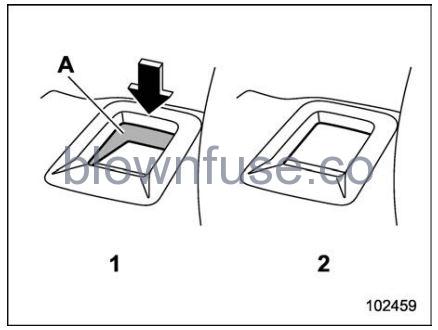
- Unlocked
- Locked
A) Unlocking marker in red
WARNING
- Before installing a child restraint system, be sure to confirm that the seatback is securely locked into place. Otherwise, in an accident, serious injury or death could result.
- Do not leave children in the car unattended. High interior temperatures may cause heatstroke and dehydration that result in serious injury or death.
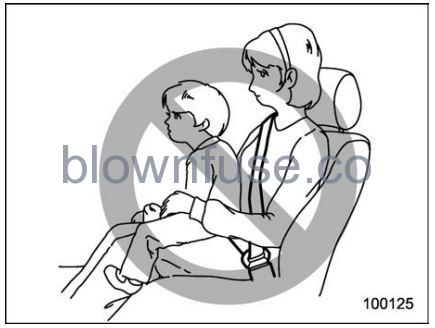
WARNING
Never let a passenger hold a child on his or her lap or in his or her arms while the vehicle is moving. The passenger cannot protect the child from injury in a collision, because the child will be caught between the passenger and objects inside the vehicle. Additionally, holding a child in your lap or arms in the front seat exposes that child to another serious danger. Since the SRS airbag deploys with considerable speed and force, the child could be injured or even killed.
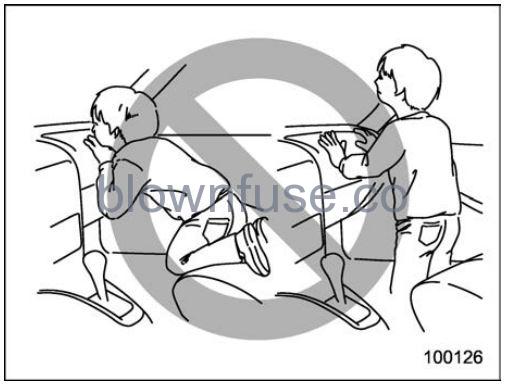
WARNING
Children should be properly restrained at all times. Never allow a child to stand up, or to kneel on any seat. Unrestrained children will be thrown forward during a sudden stop or in an accident and can be injured seriously. Additionally, children standing up or kneeling on or in front of the front seat are exposed to another serious danger. Since the SRS airbag deploys with considerable speed and force, the child could be injured or even killed.
Safety Tips for Installing Child Restraint Systems
WARNING
- Do not use a seatbelt extender. If a seatbelt extender is used when installing a child restraint system, the seatbelt will not securely hold the child restraint system. Use of a seatbelt extender could cause death or serious injury to children or other passengers in sudden braking, swerving, or accidents.
- Attach the child restraint system to the anchors properly. When using the LATCH anchors, be sure that there are no foreign objects around the anchors. Make sure the child restraint system is securely attached. Otherwise, it may cause death or serious injury to children or other passengers in sudden braking, swerving, or accidents.
- Child restraint systems and seatbelts can become hot in a vehicle that has been closed up in sunny weather; they could burn a small child. Check the child restraint system before you place a child in it.
- Do not leave an unsecured child restraint system in your vehicle. Unsecured child restraint systems can be thrown around inside of the vehicle in a sudden stop, turn or accident; they can strike and injure vehicle occupants as well as result in serious injuries or death to the child.
CAUTION
When you install a child restraint system, follow the manufacturer’s instructions supplied with it. After installing the child restraint system, check to ensure that it is held securely in position. If it is not held tight and secure, the danger of your child suffering personal injury in the event of an accident may be increased.
Where to Place a Child Restraint System
The following descriptions are SUBARU’s recommendations on where to place a child restraint system in your vehicle.
WARNING
- Several types of child restraint systems may conceal the buckle of the neighboring seat. If the occupant of the neighboring seat cannot correctly fasten the seatbelt, that person must move to a different seat. If the seatbelt cannot be correctly fastened, there is the risk of serious injury or death in the event of sudden braking or a collision.
- If the child restraint system cannot be correctly installed because it contacts the driver’s seat, moves the child restraint system to a different seat. If it cannot be installed in a different seat (other than the driver’s seat), adjust the front seat so that contact does not occur.
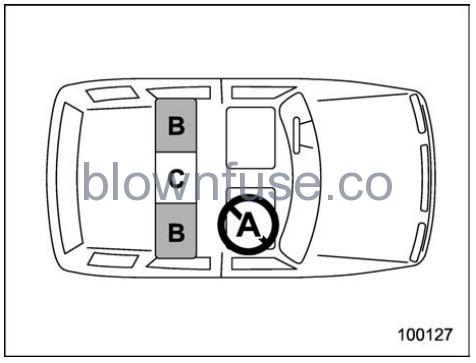
A: Front passenger’s seat
You should not install a child restraint system (including a booster seat) due to the hazard to children posed by the passenger’s airbag.
B: Rear seat, window-side seating positions
Recommended positions for all types of child restraint systems. In these positions, the following equipment is provided for installing a child restraint system.
- Automatic Locking Retractor/Emergency Locking Retractor (ALR/ELR) seatbelts
- Lower anchorages (bars)
- Upper anchorages (tether anchorages)
Some types of child restraint systems might not be able to be secured firmly due to the projection of the seat cushion. In this seating position, you should use only a child restraint system that has a bottom base that fits snugly against the contours of the seat cushion and can be securely retained using the seatbelt.
C: Rear seat, center seating position (U.S.-spec. models)
In this position, the following equipment is provided for installing a child restraint system.
- ALR/ELR seatbelts
- Lower anchorages (bars)
- Top tether anchorages
Some types of child restraint systems might not be able to be secured firmly due to the projection of the seat cushion. In this seating position, you should use only a child restraint system that has a bottom base that fits snugly against the contours of the seat cushion and can be securely retained using the seatbelt. The rear center seat includes lower anchorages, and the lower anchorages on the center side of the rear right seat can be used to install a child restraint system. When a child restraint system is installed in the rear center seat using the lower anchorages, do not sit in the rear right seat.
If a child restraint system is not correctly fixed in place (for example, if a child restraint system can be moved more than 1 inch (2.5 cm) from side to side), the child restraint system should be moved to a window seat position of the rear seat.
C: Rear seat, center seating position (other models)
In this position, the following equipment is provided for installing a child restraint system.
- ALR/ELR seatbelts
- Top tether anchorages
Some types of child restraint systems might not be able to be secured firmly due to the projection of the seat cushion. In this seating position, you should use only a child restraint system that has a bottom base that fits snugly against the contours of the seat cushion and can be securely retained using the seatbelt. When you install a child restraint system in the rear seat’s center seating position, raise the center head restraint.
Lower anchorages (bars) for window-side seating positions may be used for a seat in the center seating position if a child restraint system manufacturer’s instructions permit and specify using anchors asfar apart as those in this vehicle. If a child restraint system is not correctly fixed in place (for example, if a child restraint system can be moved more than 1 inch (2.5 cm) from side to side), you should install the child restraint system in a rear seat, window-side seating position.
WARNING]
- Even with advanced airbags, children can be seriously injured by the airbag. Seat children in the rear seat properly restrained at all times. The SRS airbag deploys with considerable speed and force and can injure or even kill children, especially if they are not restrained or improperly restrained. Because children are lighter and weaker than adults, their risk of being injured from deployment is greater. For that reason, be sure to secure ALL types of child restraint systems in the REAR seats at all times. You should choose a restraint system which is appropriate for the child’s age, height and weight. According to accident statistics, children are safer when properly restrained in the rear seating positions than in the front seating positions.
- Do not use lower anchorages (bars) for a seat in the center seating position unless a child restraint system manufacturer’s instructions permit and specify using anchors spaced as far apart as those in this vehicle.
- Do not connect two or more lower hooks onto the same anchorage (bar).
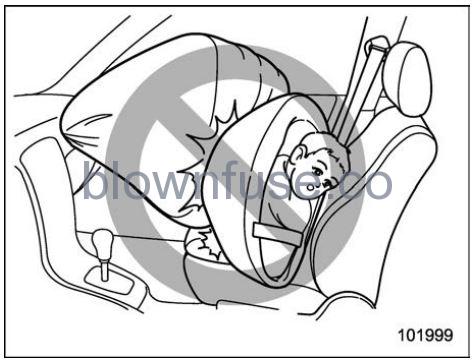
WARNING
- SINCE YOUR VEHICLE IS EQUIPPED WITH A PASSENGER’S SRS AIRBAG, NEVER INSTALL A CHILD RESTRAINT SYSTEM IN THE FRONT PASSENGER’S SEAT. DOING SO RISKS SERIOUS INJURY OR DEATH TO THE CHILD BY PLACING THE CHILD’S HEAD TOO CLOSE TO THE SRS AIRBAG.
- Do not allow children to lean their heads or any other parts of their bodies against the door or the area of the seat, front and rear pillars or roof side rails. The SRS side airbags and SRS curtain airbags deploy even if children are seated in the child restraint system. It will be dangerous if the SRS side airbags and SRS curtain airbags inflate. The impact could cause death or serious injury to the child.
- To secure the child restraint system, be sure to comply with all installation instructions provided by the child restraint system manufacturer. Not doing so could result in death or serious injury to children in a sudden stop or accident.
Choosing a Child Restraint System
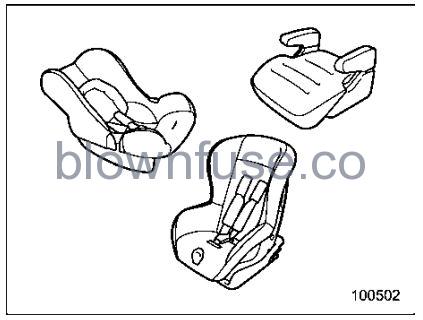
Choose a child restraint system that is appropriate for the child’s age and size (weight and height) in order to provide the child with proper protection. The child restraint system should meet all applicable requirements of Federal Motor Vehicle Safety Standards for the United States or of Canada Motor Vehicle Safety Standards for Canada. It can be identified by looking for the label on the child restraint system or the manufacturer’s statement of compliance in the document attached to the system. Also it is important for you to make sure that the child restraint system is compatible with the vehicle in which it will be used.
NOTE
Some sizes of child restraint systems may not fit the vehicle seat. Before purchasing a child restraint system, check whether it fits on the vehicle seat.
Installing Child Restraint Systems with ALR/ELR Seatbelt
CAUTION
- When you install a child restraint system, follow the manufacturer’s instructions supplied with it. After installing the child restraint system, check to ensure that it is held securely in position. If it is not held tight and secure, the danger of your child suffering personal injury in the event of an accident may be increased.
- When installing a child restraint system in the rear center seating position, set both seatbacks to the original position. Otherwise, the child restraint system cannot be securely restrained, which may result in death or serious injuries in the event of a sudden stop, sudden steering maneuver or an accident.
Installing a rearward-facing child restraint system
WARNING
- NEVER INSTALL A CHILD RESTRAINT SYSTEM IN THE FRONT PASSENGER’S SEAT. DOING SO RISKS SERIOUS INJURY OR DEATH TO THE CHILD BY PLACING THE CHILD’S HEAD TOO CLOSE TO THE SRS AIRBAG.
- Before installing a child restraint system, be sure to confirm that the seatback is securely locked into place. Otherwise, in an accident, serious injury or death could result.
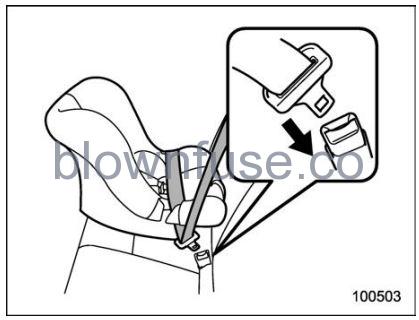
- Move the seatback back and forth to confirm that it is securely locked into place.
- Check that the red colored unlocking marker on the lock release button is not visible. For details, refer to “Folding Down the Rear Seatback” FP42.
- Place the child restraint system in the rear seating position.
WARNING
When you intend to install a child restraint system in the rear center seating position, if the child restraint system does not fit snugly against the contours of the rear center seat cushion, install the child restraint system in the window-side seating position to be safe. For details, refer to “Where to Place a Child Restraint System” FP61. - Run the lap and shoulder belt through or around the child restraint system following the instructions provided by its manufacturer.
- Insert the tongue plate into the buckle until you hear a click.
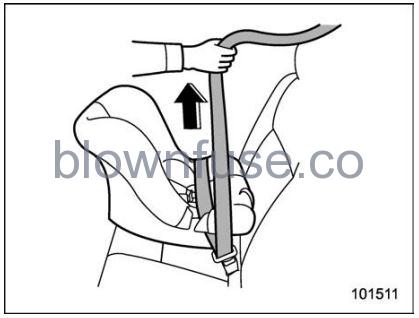
- Take up the slack in the lap belt.
- If using the seatbelt in the ALR mode is recommended by the manufacturer’s instructions supplied with the child restraint system, perform the following procedure.
- Pull out the seatbelt fully from the retractor to change the retractor over from the Emergency Locking Retractor (ELR) to the Automatic Locking Retractor (ALR) mode.
- Allow the belt to rewind into the retractor. As the belt is rewinding, clicks will be heard which indicate the retractor functions as ALR.
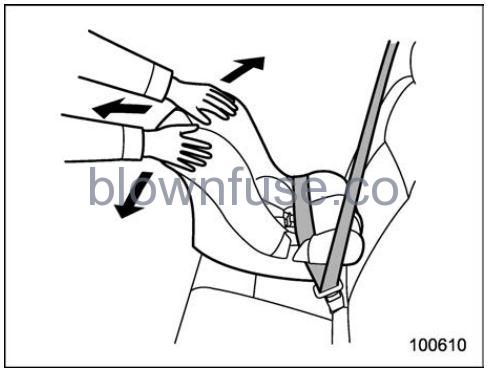
- Push and pull the child restraint system forward and side to side to check that it is firmly secured in the center of the seat. Sometimes a child restraint system can be more firmly secured by pushing it down into the seat cushion and then tightening the seatbelt.
- If the seatbelt has been set to the ALR mode in step 5, pull at the shoulder portion of the belt to confirm that it cannot be pulled out (ALR properly functioning).
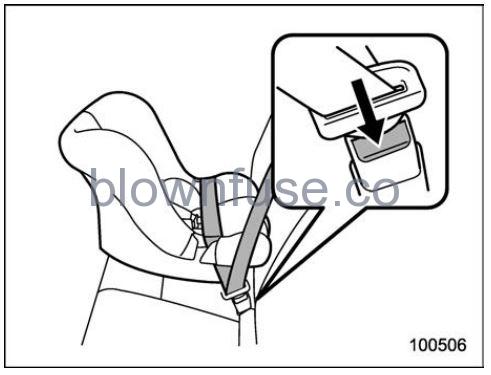
- To remove the child restraint system, press the release button on the seatbelt buckle and allow the belt to retract completely. The belt will return to the ELR mode.
NOTE
When the child restraint system is no longer in use, remove it and restore the ELR function of the retractor. That function is restored by allowing the seatbelt to retract fully.
Installing a forward-facing child restraint system
WARNING
- NEVER INSTALL A CHILD RESTRAINT SYSTEM IN THE FRONT PASSENGER’S SEAT. DOING SO RISKS SERIOUS INJURY OR DEATH TO THE CHILD BY PLACING THE CHILD’S HEAD TOO CLOSE TO THE SRS AIRBAG.
- Before installing a child restraint system, be sure to confirm that the seatback is securely locked into place. Otherwise, in an accident, serious injury or death could result.
- Move the seatback back and forth to confirm that it is securely locked into place.
- Check that the red colored unlocking marker on the lock release button is not visible. For details, refer to “Folding Down the Rear Seatback” FP42.
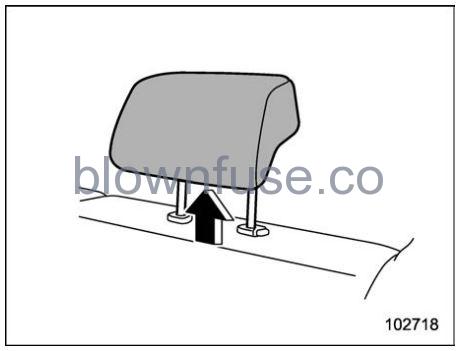
- Check that the red colored unlocking marker on the lock release button is not visible. For details, refer to “Folding Down the Rear Seatback” FP42.
- If the child restraint system makes contact with the head restraint of the rear seating position where the child restraint system is to be installed, raise the head restraint to the extended position. If the child restraint system still makes contact, remove the head restraint. For details, refer to “Head Restraint Adjustment” FP44.
CAUTION
Store the head restraint that has been removed in the trunk (Legacy) or cargo area (Outback/Subaru Outback Wilderness). Do not place the head restraint in the passenger compartment to prevent it from being thrown around in the passenger compartment in a sudden stop or a sharp turn. - For Outback/Subaru Outback Wilderness models, adjust the seatback to the upright position.
- Place the child restraint system in the rear seating position.
WARNING
When you intend to install a child restraint system on the rear center seating position, if the child restraint system does not fit snugly against the contours of the rear center seat cushion, install the child restraint system on the window-side seating position to be safe. For details, refer to “Where to Place a Child Restraint System” FP61.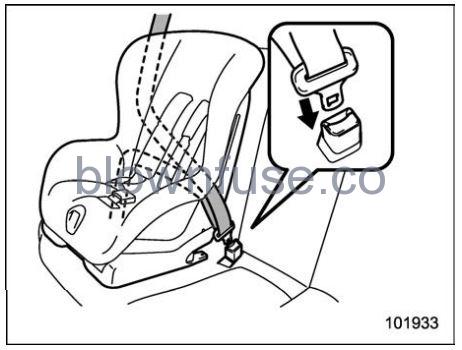
- Run the lap and shoulder belt through or around the child restraint system following the instructions provided by its manufacturer
- When a child restraint system is installed in the rear center seating position of an Outback/Subaru Outback Wilderness, pass the rear center seatbelt through the belt guide properly. For details, refer to “Rear center seatbelt on Outback/Subaru Outback Wilderness” FP51.
- Insert the tongue plate into the buckle until you hear a click.
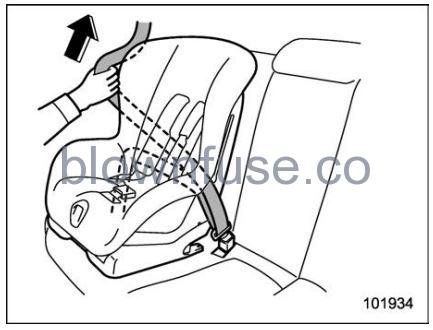
- Take up the slack in the lap belt.
- Pull out the seatbelt fully from the retractor to change the retractor over from the Emergency Locking Retractor (ELR) to the Automatic Locking Retractor (ALR) function. Then, allow the belt to rewind into the retractor. As the belt is rewinding, clicks will be heard which indicate the retractor functions as ALR.
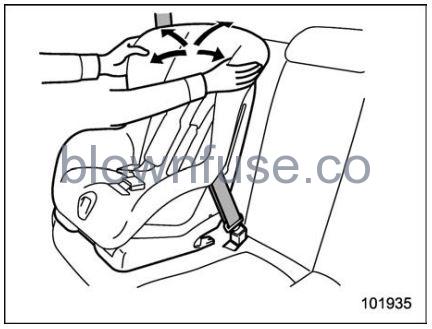
- Before having a child sit in the child restraint system, try to move it back and forth and right and left to check if it is firmly secured. Sometimes a child restraint system can be more firmly secured by pushing it down into the seat cushion and then tightening the seatbelt.
- Pull at the shoulder portion of the belt to confirm that it cannot be pulled out (ALR properly functioning).
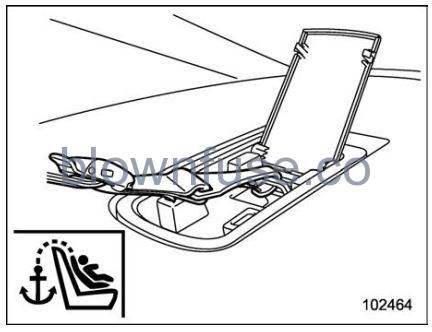
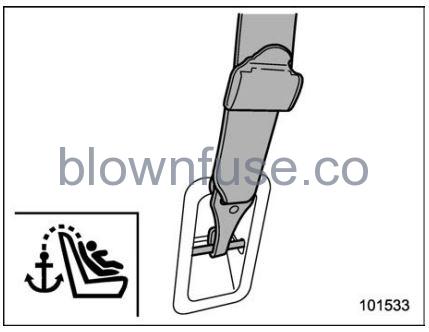
- Latch the top tether hook onto the tether anchorage that is located behind the rear seat and tighten the top tether firmly. For additional instructions, refer to “Top Tether Anchorages” FP75.
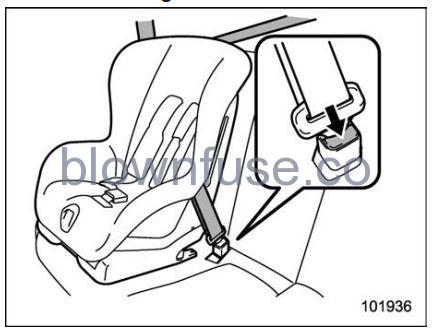
- To remove the child restraint system, press the release button on the seatbelt buckle and allow the belt to retract completely. The belt will return to the ELR mode.
Remember that the head restraint is not intended to be used at the lowest position(retracted position). Therefore, when the rear center seat is occupied (including when a child restraint system is installed), be sure to raise the head restraint to the extended position.
NOTE
When the child restraint system is no longer in use, remove it and restore the ELR function of the retractor. That function is restored by allowing the seatbelt to retract fully.
Installing a Booster Seat or Booster Cushion
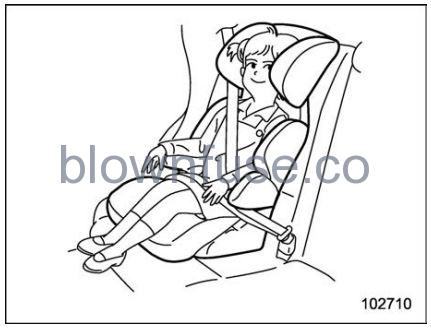
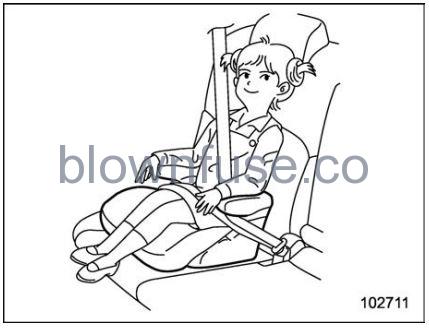
WARNING
Before installing a booster seat/cushion, be sure to confirm that the seatback is securely locked into place. Otherwise, in an accident, serious injury or death could result.
- Move the seatback back and forth to confirm that it is securely locked into place.
- Check that the red colored unlocking marker on the lock release button is not visible. For details, refer to “Folding Down the Rear Seatback” FP42.
- Adjust the head restraint as follows.
For booster seat:
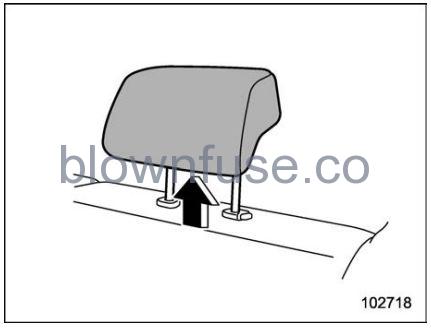
Raise the head restraint to the extended position. If the booster seat still makes contact, remove the head restraint. For details, refer to “Head Restraint Adjustment” FP44.
CAUTION
Store the head restraint that has been removed in the trunk (Legacy) or cargo area (Outback/Subaru Outback Wilderness). Do not place the head restraint in the passenger compartment to prevent it from being thrown around in the passenger compartment in a sudden stop or a sharp turn.
For booster cushion: Raise the head restraint to the extended position. Do not remove the head restraint. - For Outback/Subaru Outback Wilderness models, adjust the seatback to the upright position.
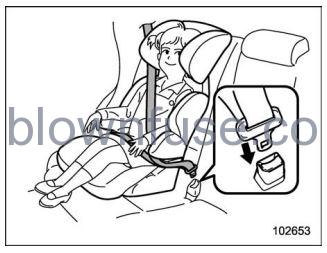
- Place the booster seat/cushion in the rear seating position and sit the child on it. The child should sit well back on the booster seat/cushion.
- Run the lap and shoulder belt through or around the booster seat/cushion and the child following the instructions provided by its manufacturer. For booster seat/cushion with a belt guide, use the seatbelt through the belt guide.
- Insert the tongue plate into the buckle until you hear a click. Take care not to twist the seatbelt.
Make sure the shoulder belt is positioned across the center of child’s shoulder and that the lap belt is positioned as low as possible on the child’s hips.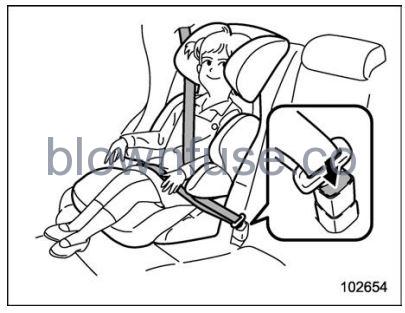
- To remove the booster seat/cushion, press the release button on the seatbelt buckle and allow the belt to retract.
WARNING
- Never use a belt that is twisted or reversed. In an accident, this can increase the risk or severity of injury to the child.
- Never place the shoulder belt under the child’s arm or behind the child’s back. If an accident occurs, this can increase the risk or severity of injury to the child.
- The seatbelt should fit snugly in order to provide full restraint. Loose-fitting belts are not as effective in preventing or reducing injury.
- Place the lap belt as low as possible on the child’s hips. A high-positioned lap belt will increase the risk of sliding under the lap belt and of the lap belt sliding up over the abdomen, and both can result in serious internal injury or death.
- Make sure the shoulder belt is positioned across the center of the child’s shoulder. Placing the shoulder belt over the neck may result in neck injury during sudden braking or in a collision.
Installation of Child Restraint Systems by Use of Lower and Tether Anchorages (LATCH)
Lower and tether anchorages
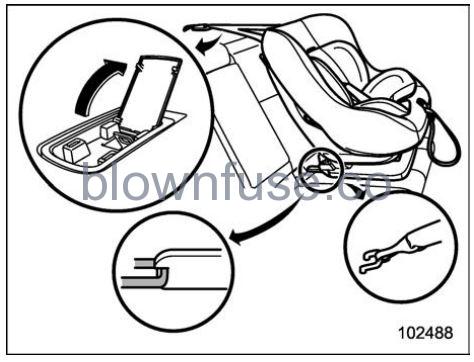
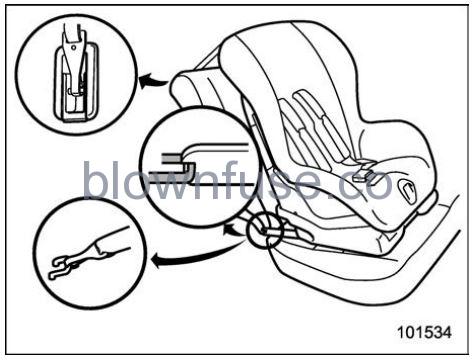
WARNING
- Attach the child restraint system to the anchors properly. When using the LATCH anchors, be sure that there are no foreign objects around the anchors. Make sure the child restraint system is securely attached. Otherwise, it may cause death or serious injury to children or other passengers in sudden braking, swerving, or accidents.
- When installing a child restraint system using LATCH anchors with the rear seatbelt fastened, ensure that the rear seatbelt does not become caught in the child restraint system or the lower LATCH anchorages.
NOTE
The seatbelt warning system of the rear seats detects if any of the seats are occupied by a passenger. Installing a child restraint system in the rear seating area, using the LATCH anchors, may result in the activation of the passenger seatbelt warning light and chime. Fastening the rear seatbelt prior to installing the child restraint system will avoid activating the passenger seatbelt warning light and chime. For details, refer to “Rear passenger’s seats” FP181.
Some types of child restraint systems can be installed on the rear seat of your vehicle without use of the seatbelts. Such child restraint systems are secured to the dedicated anchorages provided on the vehicle body.
The lower and tether anchorages are sometimes referred to as the LATCH system (Lower Anchors and Tethers for Children).
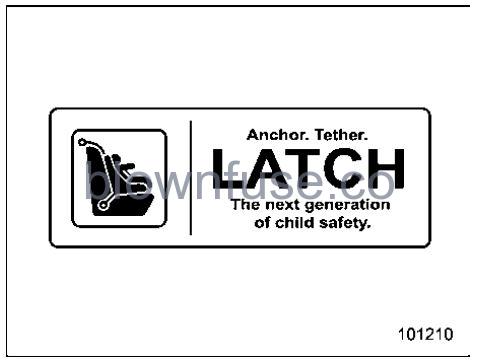
Your vehicle is equipped with five lower anchorages (bars) (U.S.-spec. models) four lower anchorages (bars) (other models) and three upper anchorages (tether anchorages) for accommodating such child restraint systems.
Lower anchorages
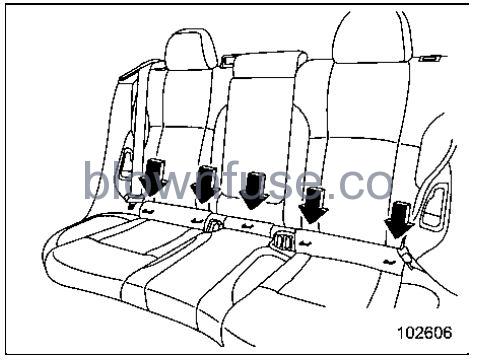
WARNING
Do not connect two or more lower hooks onto the same anchorage (bar).
There are a total of 5 lower anchorages at the rear seat. The rear anchorage from the right side is used for both the right seat and center seat. Each lower anchorage is located where the seat cushion meets the seatback.
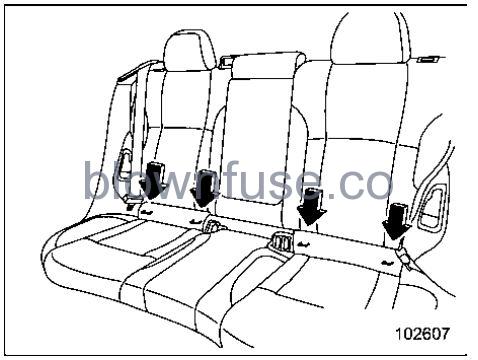
WARNING
Do not connect two or more lower hooks onto the same anchorage (bar).
Two lower anchorages (bars) are provided for installing a child restraint system on the rear seat window-side seating positions. Lower anchorages (bars) for window-side seating positions may be used for a seat in the center seating position if a child restraint system manufacturer’s instructions permit and specify using anchors as far apart as those in this vehicle. Each lower anchorage is located where the seat cushion meets the seatback.
Tether anchorages
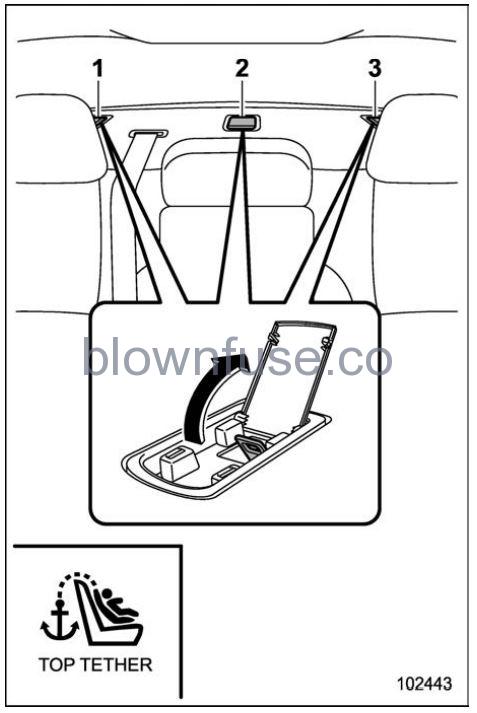
Legacy
- For right seat
- For center seat
- For left seat
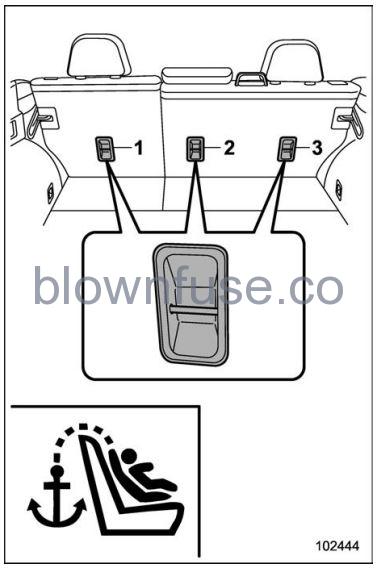
Outback/Subaru Outback Wilderness
- For left seat
- For center seat
- For right seat
The tether anchorages (upper anchorages) are provided at the locations shown in the above illustration. For details,refer to “Top Tether Anchorages” FP75.
To install a child restraint system using lower and tether anchorages
WARNING
Before installing a child restraint system, be sure to confirm that the seatback is securely locked into place. Otherwise, in an accident, serious injury or death could result.
- Move the seatback back and forth to confirm that it is securely locked into place.
- Check that the red colored unlocking marker on the lock release button is not visible. For details, refer to “Folding Down the Rear Seatback” FP42.
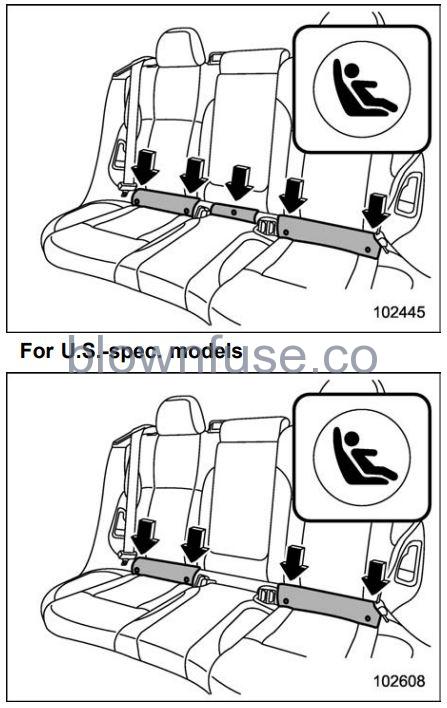
- Check that the red colored unlocking marker on the lock release button is not visible. For details, refer to “Folding Down the Rear Seatback” FP42.
- You will find “ ” marks at the bottoms of the rear seatback. These marks indicate the positions of the lower anchorages (bars).
Each lower anchorage is located behind the cover of the seatback bottom.
CAUTION
When you install a child restraint system, follow the manufacturer’s instructions supplied with it. After installing the child restraint system, check to ensure that it is held securely in position. If it is not held tight and secure, the danger of your child suffering personal injury in the event of an accident may be increased.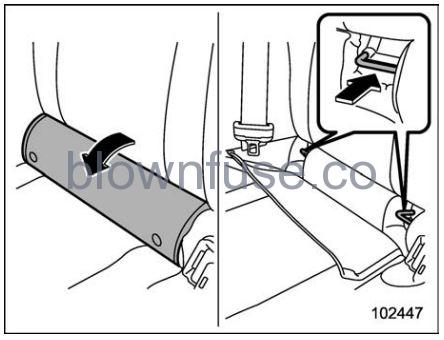
Peel off the anchorage cover completely from the selected side of the rear seatback to expose the anchorages (bars) to be used for installation of the child restraint system. If it is hard to install the child restraint system because the anchorage cover returns to the original position, press the anchorage cover to the seat cushion until it is flat.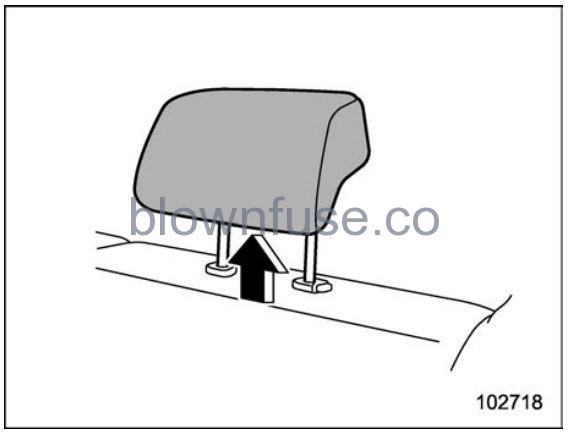
- If the child restraint system makes contact with the head restraint of the rear seating position where the child restraint system is to be installed, raise the head restraint to the extended position. If the child restraint system still makes contact, remove the head restraint. For details, refer to “Head Restraint Adjustment” FP44.
CAUTION
Store the head restraint that has been removed in the trunk (Legacy) or the cargo area (Outback/Subaru Outback Wilderness). Do not place the head restraint in the passenger compartment to prevent it from being thrown around in the passenger compartment in a sudden stop or a sharp turn.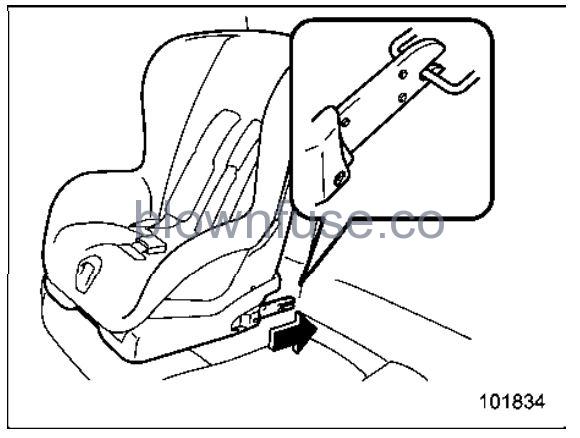
- For Outback/Subaru Outback Wilderness models, adjust the seatback to the upright position.
- While following the instructions supplied by the child restraint system manufacturer, connect the lower hooks onto the lower anchorages located at
 marks on the bottom of the rear seatback. When the hooks are connected, make sure the adjacent seatbelts are not caught.
marks on the bottom of the rear seatback. When the hooks are connected, make sure the adjacent seatbelts are not caught.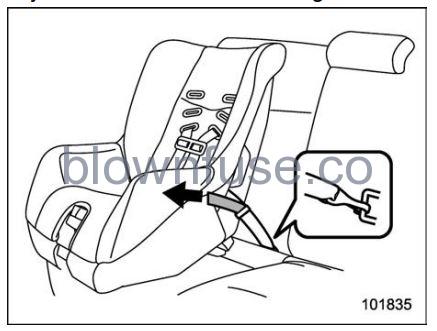
- If your child restraint system is a flexible attachment type (which uses tether belts), push the child restraint system into the seat cushion and pull both left and right lower tether belts up to secure the child restraint system by taking up the slack in the belt.
- Latch the top tether hook onto the tether anchorage that is located on the rear shelf (Legacy)/behind the rear seat (Outback/Subaru Outback Wilderness) and tighten the top tether firmly. For additional instructions, refer to “Top Tether Anchorages” FP75.
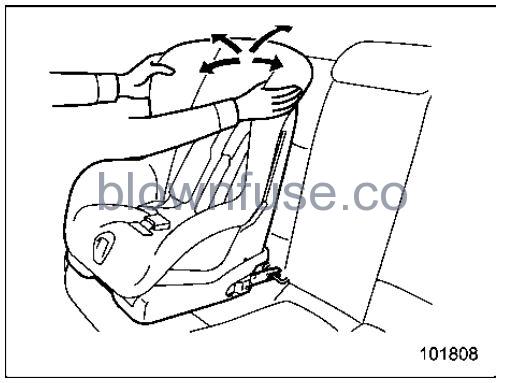
- Before seating a child in the child restraint system, try to move it back and forth and left and right to verify that it is firmly secured in the center of the seat.
- To remove the child restraint system, follow the reverse procedures of installation.
If you have any question concerning this type of child restraint system, ask your SUBARU dealer.
Top Tether Anchorages
Your vehicle is equipped with three top tether anchorages so that a child restraint system having a top tether can be installed in the rear seat. When installing a child restraint system using top tether, proceed as follows, while observing the instructions by the child restraint system manufacturer. Since a top tether can provide additional stability by offering another connection between a child restraint system and the vehicle, we recommend that you use a top tether whenever one is required or available.
Tether anchorage location
Legacy
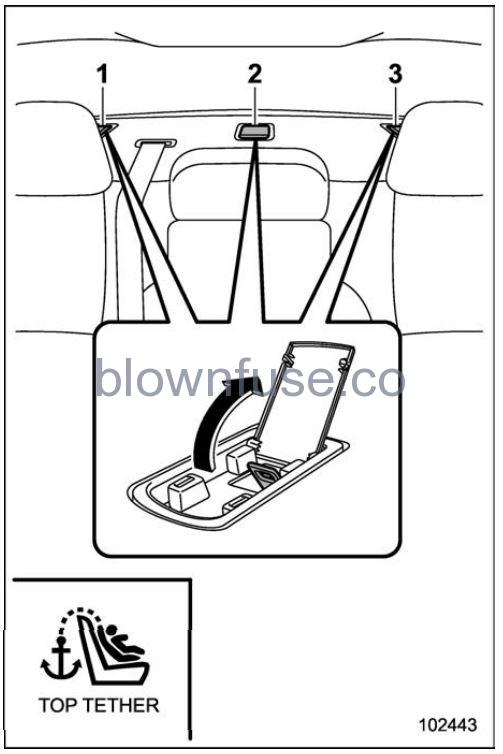
- For right seat
- For center seat
- For left seat
Three tether anchorages are installed on the rear shelf behind the rear seat head restraint. Open the cover flap to use each anchorage.
Outback/Subaru Outback Wilderness

- For left seat
- For center seat
- For right seat
Three tether anchorages, i.e., ones for the right, center and left positions, are already installed on the backside of the rear seatback.
To hook the top tether
CAUTION
- Always raise the head restraint when mounting a child restraint system with a top tether. Failure to do so may prevent the top tether from being fastened tightly.
- If the head restraint is removed, store the head restraint in the trunk (Legacy) or the cargo area (Outback/Subaru Outback Wilderness).
- Do not place the head restraint in the passenger compartment to prevent it from being thrown around in the passenger compartment in a sudden stop or a sharp turn.
Legacy
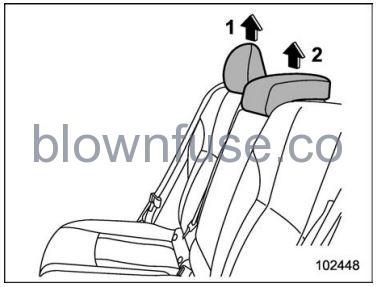
- When installing on the window-side seating position
- When installing on the rear center seating position
- Raise the head restraint at the seating position where the child restraint system is to be installed with the seatbelt or lower anchorages.
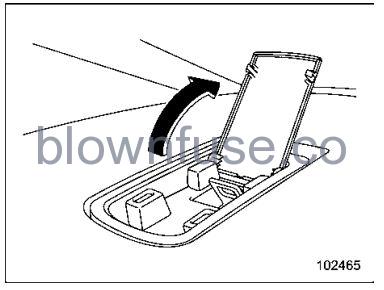
- Open the cover flaps to use the anchorages.
- Pass the top tether between the head restraint and seatback.
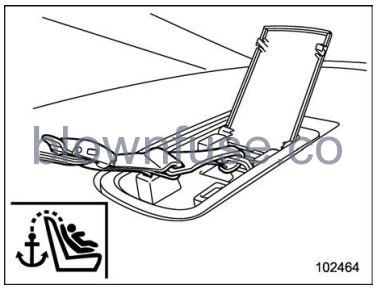
- Fasten the top tether hook of the child restraint system to the appropriate upper anchorage.
- Tighten the top tether securely. Contact your SUBARU dealer if you have any questions regarding the installation of a child restraint system.
Outback/Subaru Outback Wilderness
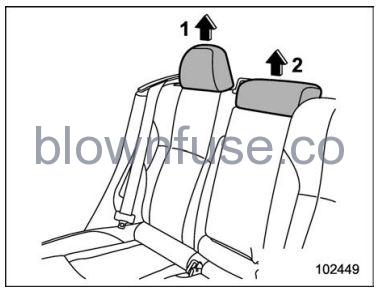
- When installing on the window-side seating position
- When installing on the rear center seating position
- Raise the head restraint at the seating position where the child restraint system is to be installed with the seatbelt or lower anchorages.
- Adjust the seatback to the upright position.
- Pass the top tether between the head restraint and seatback.
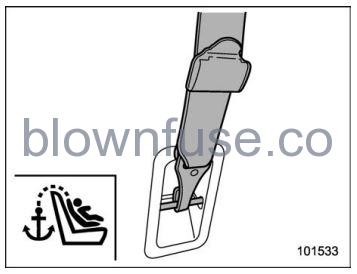
- Attach the top tether hook to the appropriate upper anchorage.
- Tighten the top tether securely. Contact your SUBARU dealer if you have any questions regarding the installation of a child restraint system.
